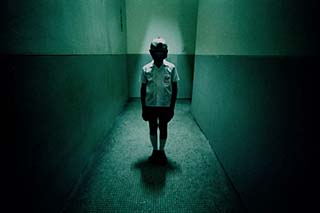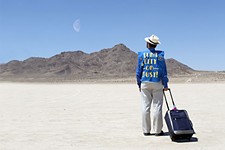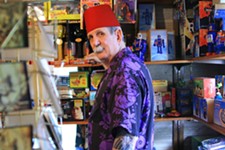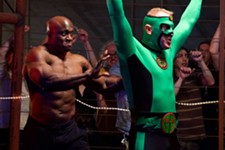They See Dead People, Too
The Asian horror boom continues with The Pang brothers' 'The Eye'
By Marc Savlov, Fri., June 27, 2003

True story: I bought a new DVD player last week to replace my aging Apex, which had begun a slow decline into unreliability. The replacement was a slim Korean-made Daewoo that could read not only DVDs, but also MP3 discs, mini-VCDs, and a handful of other digitally compressed formats that were unlikely to crop up anywhere outside of the corner Asian grocery.
The really great thing, though, was the fact that the Daewoo had a hidden menu screen that could be accessed by entering a sequence of numbers and letters on the remote control's keypad. Entered properly, this code would reveal a wealth of apparently secret geek features, including one that could disable the anti-piracy program Macrovision and, best of all, another that would allow the playing of discs from any of the nine global DVD regions (and not just American Region 1). This meant I could finally begin catching up on all the import Asian horror films that Pedazo Chunk video specializes in, something I'd been meaning to do since I discovered Hideo Nakata's Ringu last year.
Over the next few days I fed the Daewoo a steady diet of Korean, Thai, Japanese, and HK horror shows: Ryuhei Kitamura's Versus, with its kata-chopped zombie gore; Kuo-Fu Chen's Double Vision, a cop film masquerading as a supernatural thriller and starring American David Morse and Tony Leung (which is getting a U.S. DVD release from Columbia/Tristar later this summer); South Korean Byeong-Ki Ahn's Phone, which superbly transfers Ringu's subtle fear of one technology (home video) to another (cell phones), and finally Jôji Iida's Spiral, the first of several Ringu sequels.
For a while there, the Daewoo and I were getting along famously, and a crimson river of Asian horror flowed from it to my JVC like so much bloody wasabi and blackened, glutinous rice. An acquired taste, to be sure, but one well worth savoring.
Then the Daewoo got sick. It began misreading the DVDs, choking up, and issuing strange grinding sounds in Dolby 5.1 surround. Soon it wouldn't play anything, no matter what button I pushed. Frustrated, I shut it off, unplugged it, and sulked. And that's when the loading tray began opening on its own, ever so slowly, like the unfurling of a black plastic tongue. That was enough, at 11pm at night, to get me to return it to the store, and lay off the horror for a while. For the moment I'm without a player, but then I think that's better than Sadako-san's digital maw creeping up on me. My VHS works just fine.
Asian horror films are enjoying something of a renaissance these days, or at least a newfound popularity stateside. The unexpected success of Gore Verbinski's remake The Ring has opened the door this summer for another summarily unnerving creeper The Eye, from Thai-born sibling directors Oxide and Danny Pang. (The Eye had its U.S. premiere at SXSW Film 2003.) The story of a young blind woman who undergoes a corneal transplant and begins to see visions of the dead, The Eye may sound familiar to fans of The Sixth Sense, but the Pangs' film is a far more creepy affair than M. Night Shyamalan's crowd-pleaser.
Ever since Masaki Kobayashi made the ground-breaking supernatural anthology-film Kwaidan way back in 1964 -- thereby giving most international filmgoers their first taste of Japanese and Asian horror -- Eastern horror filmmakers have been a breed apart. These days, as American horror spirals unchecked into a pit of self-referential ironic comedy and hack 'n' slash splatter that was already stale when the mid-Eighties horror glut washed through theatres, Asian imports like The Eye are mining a vastly more atmospheric and memorable vein of fear -- less blood, more creeping malaise.
In The Eye, the Pangs mine the peripheral -- it's not what the protagonist sees so much as what she thinks she sees, and like those random visual anomalies that begin to crop up when you've gone too long without sleep, the strangeness mounts just beyond visual acuity. Sudden movements, blurred figures in the distance, fragments of coherent information -- The Eye is a primer on how to scare the bejeezus out of audiences without subjecting them to outright horror. It's so unlike what American audiences are used to it might as well be from another planet.
We corresponded with the Pang brothers via e-mail on the eve of the American release of The Eye (distributed here by Palm Pictures) and tried to get a handle on what makes their cinematic vision so jarringly original. And since you're already wondering, the name Oxide was "adopted during a chemistry lesson" while the director was still a high school student. ...
Austin Chronicle: Haunted body parts are nothing new in the horror genre, but The Eye nonetheless feels extremely original in how it goes about reimagining the tropes. Was there any particular background to your script?
Pang brothers: The story was inspired by a dramatic suicide on the radio news years ago. A young woman ended her life after regaining her sight from a cornea transplant only a week before. As we did more research on the woman, we realized that she had been a tough, energetic, and positive person throughout her life. She had contributed so much to the blind community that her suicide left a devastating effect [on] everyone she knew. Her suicide puzzled and upset us as no one in the community could offer any conclusion or speculation upon her sudden end.
We have of course fictionalized the rest ... but personally speaking, we really wanted to offer a different end to her life.
So we hypothesized on what she could have possibly seen that was so devastating. The sighting of spirits was one of the logical outcomes. To the seeing people, the concept of ghosts is not something beyond our imagination. It is scary but not profoundly outrageous. However, to someone who has been blind for most of her life, she would not be able to understand or talk about the eerie visions she sees right after her recovery. It is this insecure and helpless point of view that we employed in the film.
AC: I'm curious what -- if any -- Western horror films or directors you might be partial to.
PB: Our personal favorite is Alan Parker's Angel Heart, which was released at the time we started to take filmmaking seriously. As youngsters, we couldn't help falling for his stunning visual and editing styles -- then and still. Recent favorites would include Ringu, for its simple but effective principle of "the lesser the viewer can see, the more frightening is the scene." And we truly admire Alejandro Amenábar, who managed to deliver a very complex story in [a] subtle but creepy manner in The Others.
AC: Ghost stories, cinematic or otherwise, seem to have a more socially ingrained relevance in Asian cultures as opposed to the West, where they tend to end up ghettoized or thought of as fodder for youngsters. Is this because Asian cultures are somehow more attuned to the idea of human mortality? How does this play into your film?
PB: We suppose it's because of the Buddhist roots of Asian cultures that the concept of reincarnation is generally accepted (thereby so are the concept of fate and the concept of spiritual coexistence) without necessarily [being] insist[ed] on. That's why ghost stories are more readily accepted and produced more often here. But only a limited number would get immensely popular like a major picture. We don't think Asian cultures are necessarily more attuned to the idea of mortality. On a fictional level, perhaps they are. But death is indeed a personal matter, and it varies by case. We'd rather say that Asians accept deaths with different tools, and only if the individual is willing to, to begin with. Accepting fate itself is one of the options.
AC: How do you share the workload on your films? Are you both writer/directors, or is there a clear demarcation of duty?
PB: We work together by all means. And on set, we work by shift. We pitch ideas toward each other whenever we find something exciting and develop the story together. Between the two of us, our characters and behaviors are very different, but we know each other so very well that partnership is the only natural outcome. We can pretty much settle on the treatment of every scene during the writing process, so by the time we shoot, only one of us is required on set, whereas the other one can edit what he has shot on the previous day. It's a very efficient way of working, plus we can spot the flaws earlier on. It's very much like one director who can handle double workload in the same time frame.
AC: Finally, any plans to make the leap stateside as so many other Asian filmmakers have done in the recent past?
PB: We have been proposed to do so but clearly it's not our concern yet. ... We think we still belong to the "up and coming" category here in Asia, and we'd rather do more groundwork here before we would evolve to [an]other level. ![]()
The Eye opens in Austin on Friday. See Film Listings for review.










